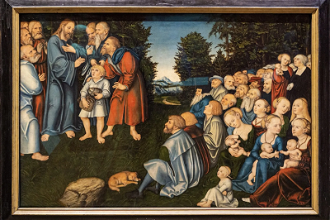Vatican releases 'Christian reflection on the 'New Age'
Source: VIS
Today in the Holy See Press Office there was a conference to present the document: Jesus Christ, Bearer of Living Water. A Christian Reflection on the 'New Age', prepared by the Pontifical Council for Culture and the Pontifical Council for Interreligious Dialogue.
Cardinal Paul Poupard, president of the council for culture and Archbishop Michael Fitzgerald, president of the council for interreligious dialogue, presided at the conference. They were joined by Fr Peter Fleetwood of the secretariat of the Council of European Episcopal Conferences and Teresa Osorio Goncalves, an official of the Pontifical Council for Interreligious Dialogue, who drafted the document.
Cardinal Poupard, citing a recent editorial he wrote, said: "The phenomenon of the New Age, together with so many other new religious movements, is one of the most urgent challenges for the Christian faith. It is a question of a religious challenge and at the same time a cultural one: the New Age proposes theories and doctrines about God, man and the world, that are incompatible with the Christian faith. In addition, the New Age is both the symptom of a culture in deep crisis and the wrong answer to this situation of cultural crisis: to its restlessness and its questions, to its aspirations and hopes."
He stressed that today's document regards this phenomenon and offers Christian reflections on the 'New Age,' adding that "today, Western culture, often followed by many others, has gone from an almost instinctive sense of the presence of God to what is often called a more 'scientific' vision of reality."
There are many reasons for this, he said, including the passage from traditional forms of religion to more personal and individual expressions of what is called "spirituality."
Cardinal Poupard said "there seem to be three distinct motives behind such a change. The first lies in the sensation that traditional religions or institutions cannot give what once they affirmed to be able to give."
Pointing to the second reason, he affirmed: "One of the most significant developments in what could be called the 'spiritual' sphere, over the last century more or less, has been a return to pre-Christian forms of religion."
"The third motive behind the rather widespread disenchantment with regards to institutional religion comes from a growing obsession in Western culture for Eastern religions and the paths of wisdom. ... The growing conviction that there is a certain basic truth, a kernel of truth in the heart of every religious experience has led to the idea that one can and must gather all characteristic elements of the diverse religions to arrive at a universal form of religion."
The cardinal reiterated what Chapter 1 says: "The document guides those involved in pastoral work in their understanding and response to New Age spirituality, both illustrating the points where this spirituality contrasts with the Catholic faith and refuting the positions espoused by New Age thinkers in opposition to Christian faith."
He also underscored another point in Chapter 1: "The beginning of the Third Millennium comes not only two thousand years after the birth of Christ, but also at a time when astrologers believe that the Age of Pisces - also known to them as the Christian Age - is drawing to a close. These reflections are about the New Age, which takes its name from the imminent astrological Age of Aquarius. The New Age is one of many explanations of the significance of this moment in history which are bombarding contemporary (particularly Western) culture, and it is hard to see clearly what is and what is not consistent with the Christian message."
Archbishop Fitzgerald explained that the council for interreligious dialogue was involved in this question for a historical reason as well as one of jurisdiction.
"The study of alternative forms of religiosity is shared by three dicasteri, including our council. This collaboration, out of which came the 1986 document 'Sects and New Religious Movements,' is continual." Stating that the document recognizes a "true 'religious' sense in those persons influenced by the New Age," he nonetheless pointed out that "a distinction must be made when one speaks of dialogue. One form of dialogue is that which one has with adherents of organized religions and includes encounters, reciprocal understanding, collaboration for peace and development, an exchange on common spiritual values. Another form consists of accompanying the individual in his search."
The archbishop then focussed on the content of the document, divided into a Foreword and nine Chapters: 1. What Sort of Reflection; 2. New Age Spirituality: An Overview; 3. New Age and Christian Faith; 4. New Age and Christian Faith in Contrast; 5. Jesus Christ Offers us the Water of Life; 6. Points to Note; 7. Appendix; 8. Resources and 9. General Bibliography. (The entire document will be availlable shortly on the Vatican website.)
Published3 February 2003


















